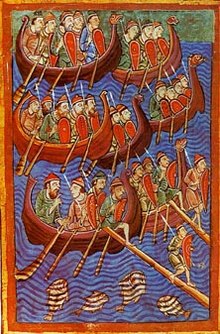By Michelle Styles
There are certain headline events which echo through the ages, such as the raid on Lindisfarne which started the Viking Age and other events which were once known and have now been largely forgotten. In the second category are the events of 794 where the Northumbrians fought back.
There are certain headline events which echo through the ages, such as the raid on Lindisfarne which started the Viking Age and other events which were once known and have now been largely forgotten. In the second category are the events of 794 where the Northumbrians fought back.
The precise reason for the Viking raid has long been consigned to annals of forgotten history, but one thing is certain. Once one Viking felag (or fellowship of warriors) had successfully raided, others undoubtedly tried their hand.
 |
| 12-century depiction of a Viking invasion source: Wikipedia |
Sure enough, Symeon of Durham records that 794 brought yet another raid. Rather than returning to Lindisfarne, the raiders struck lower down at Jarrow. This time, however, the raiders did not have it all their own way. First the raider’s chief was killed in a violent clash with English warriors. Then a great storm which became known as St Cuthbert’s storm struck, swamping the Viking long boats and making it impossible for them to escape. Symeon states the survivors were put to death.
The next time the Vikings are mentioned in connection with Northumbria is 800 when they lay waste to the monasteries at Tynemouth and Hartness. The six year interval is significant in my opinion. Other areas in Britain were attacked but not Northumbria. There is no recorded alliance or payment of gold to make them go away. The Vikings tended to strike a weak target. In 794, Northumbria had shown that it wasn’t weak, but in the intervening years, Northumbria was riven with civil war. This jeopardised its alliance with Charlemagne (which may have been one of the reasons for the original raid as shortly before this, Charlemagne had moved against the heathens to the North). Apparently in 796 Charlemagne was so angry when he heard King Athelred had been slain near Corbridge that he took back his generous gifts. He considered Northumbria nobles to be worse than pagans, but Alcuin (a bishop from Northumbria) interceded on Northumbria’s behalf and he was pacified. By 800, Northumbria had been through three more kings and had fought several wars, including at least one with Mercia. The court was also riven with gossip and intrigue.
 |
| reconstructed Viking long ship source Wikipedia |
It is interesting that the raid that gets remembered is the one which succeeded, and not the one which didn’t. One of the reasons might be that Alcuin did not feel the need to write emotive letters about St Cuthbert’s storm. He seemed to be using his considerable writing skills as a call to action. Obviously because Northumbria had succeeded in defeating the Viking threat, his skills were not required. However, I suspect that Northumbria itself was not shy in making its success known.
When I wrote Summer of the Viking, I wanted to look at what the situation on the ground after the Lindisfarne raid. It was then I discovered about St Cuthbert’s storm and its aftermath. Certainly the Viking raiders do seem to be aware of the Northumbrian strength as they stop raiding until after the third civil war. Symeon mentions with glee about how vengeance was taken on those who threatened innocent people. And of course Northumbria could not know if the Vikings would continue to raid or not.
Anyway, I thought it time that this success was better known.
Michelle Styles writes warm, witty and intimate historical romance in a wide range of time periods. Her most recent Summer of the Viking was published by Harlequin in June 2015. You can learn more about Michelle and her books on www.michellestyles.co.uk

